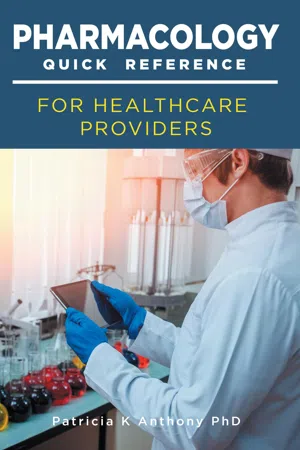![]()
Section 1
Discussion of Drug Classes
and Mechanism of Action
![]()
Pharmacology is very much an interactive science. In order to understand how a particular drug works, you must first understand the physiology and biochemical principles behind it. The following discussions will attempt to facilitate the understanding of how various classes of drugs behave in the body and the various effects that they might have. Remember that while a drug is taken to affect a particular system or organ in the body, in order to mediate a therapeutic result, the drug is free to act on any system or organ, according to its physiological effect. This is important to understand, as it will help predict how a particular patient (with a particular condition) will respond to a drug—or how two drugs or a drug taken in concert with a particular food or drink can interact and adversely affect the patient.
Drug classes, the general mechanism of action of drugs in the class, and their general contraindications and adverse effects will be presented on the following pages, arranged by therapeutic use. It should be noted that some drug classes may be useful in the therapy of a variety of conditions (indeed, many drugs are useful in the therapy of unrelated conditions, due to their adverse effects—for example, methotrexate is used in the therapy of cancer but suppresses the immune system, which makes it effective against conditions affected by the immune system [e.g., rheumatoid arthritis]). Thus, it is extremely useful for the health care provider to be knowledgeable about the way a drug works within the body (mechanism of action) and how the therapy will affect the patient.
We will begin with the management of the excitable tissues of the nervous system and heart.
Drugs That Affect the Central Nervous System
Drugs that affect the CNS are fatty in nature, which means that they may be stored in fatty tissues of the body. These drugs, in general, either alter neuronal conduction by decreasing the excitability of neuronal membranes or by altering the level of neurotransmitters available.
Anticonvulsant Agents
Anticonvulsant agents decrease neuronal excitability. They cause hyperpolarization of the membrane and make it less excitable, so that the disruptive neuronal impulses that cause seizure activity are less likely to be formed.
Anticonvulsant drugs are classified in several ways:
- Sodium channel blockers - Drugs that block the entrance of sodium across the neuronal cell membrane, causing the cell to be more difficult to stimulate
- GABA agonists - Drugs that mimic or potentiate the actions of the inhibitory neurotransmitter GABA (GABA increases the amount of negatively charged chloride ions moving across the neuronal cell membrane, causing a decrease in excitability)
- Drugs that decrease the rate of release or effect of excitatory neurotransmitters
Sodium Channel Blockers
This class of drugs includes carbamazepine, oxcarbazepine, and phenytoin. These drugs act to decrease the entrance of sodium into the cell. In excitable tissues (e.g., heart, nervous tissue), the amount of sodium that is allowed to cross the cell membrane determines the degree of excitation of the excitable cell. Blocking the entrance of sodium means that the rate of electrical conduction will be decreased and the cell will be harder to stimulate. This class of drugs is used in the therapy of seizures but may also be used as antiarrhythmic agents or as local anesthetics. By decreasing neuronal conduction in pain fibers, these drugs can also decrease the perception of pain and may be used in the therapy of nerve pain (e.g., trigeminal neuralgia). Since the entrance of sodium into the cell is critical for cellular excitation, any anticonvulsant drug that blocks sodium channels will have some effect on all types of excitable tissue (e.g., heart, nerve).
Adverse effects: These drugs may block sodium channels in the heart, resulting in a decreased rate of electrical conduction, diminished cardiac function, and an increase in fluid retention and peripheral edema. In addition, the blood plasma may be depleted of sodium (hyponatremia), and the release of hormones and neurotransmitters may be affected.
Drugs That Potentiate the Effects of GABA
Many anticonvulsant drugs increase the available amount or effects of the inhibitory neurotransmitter GABA; thus, they increase the number of negatively charged chloride ions that can enter the neuronal cell. The more positively charged the inside of the cell is, the more excitable it becomes, until finally it generates a spontaneous burst of electricity. Depending on how this occurs, it may generate a seizure. We can decrease the possibility of the formation of this extraneous burst of electricity by increasing the number of negatively charged ions entering the cell. Since GABA increases the rate of entrance of negatively charged chloride ions into the cell, a drug that mimics the effects of GABA decreases the potential for seizure formation.
This class of drugs includes vigabatrin (a drug that inhibits the breakdown of GABA), tiagabine (which increases available GABA by decreasing the neuronal uptake of GABA), and Gabapentin (a drug that potentiates the effects of GABA and increases calcium conductance, resulting in increased release of GABA). The drug also appears to increase GABA production.
Drug interactions: Because these drugs increase the effects of GABA (e.g., promote an increase...
